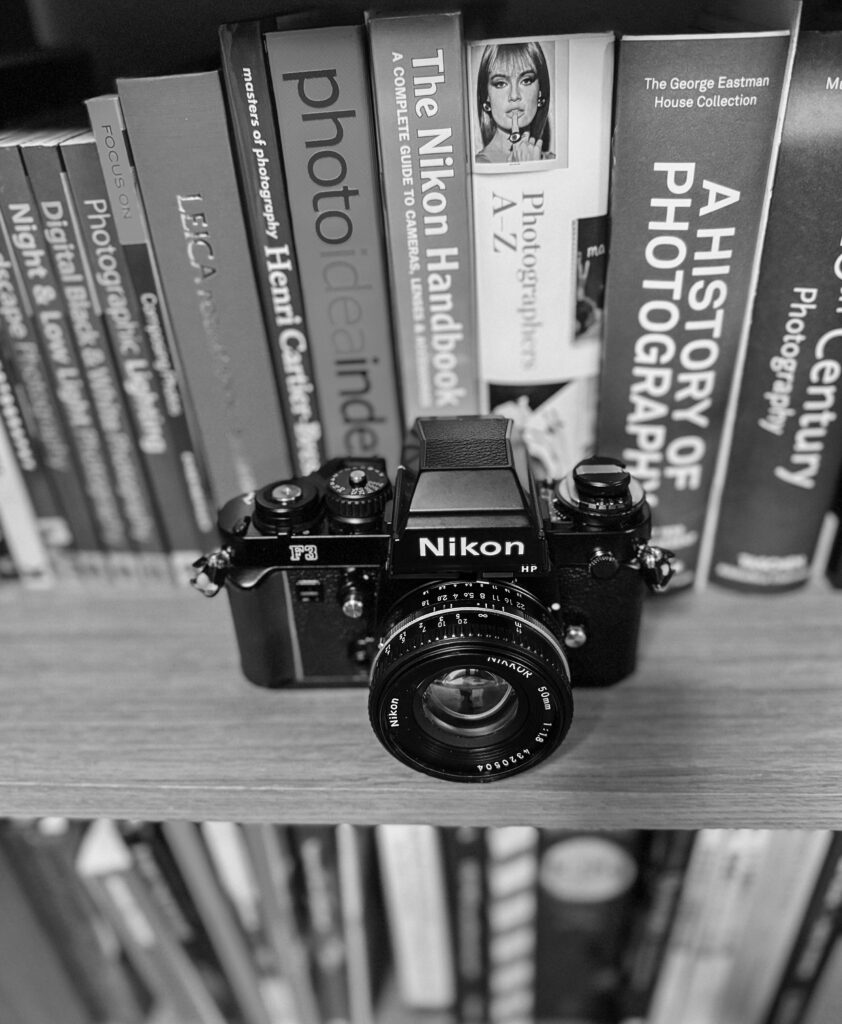I shoot with both the Leica rangefinders and the Nikon SLRs. The most frequently used are my Leica M6 TTL 0.58 and Nikon F3, which is the camera that got me back into shooting with film. They are both legendary cameras, but very different to shoot with.
I’ve found the key to knowing them better is to gain an understanding of their metering systems. These, I learned, are separated by design philosophy and intended user as well as the underlying camera technology.
Nikon: SLR TTL Metering Through the Focusing Screen
Let’s start with the SLR. The Nikon F3 is a single lens reflex (SLR)of 1980 in this example. It was built for professional photojournalists, sports photographers, and anyone needing fast, reliable exposure in unpredictable environments. The F3 has a TTL (through-the-lens) metering system. It works like this:

Nikon F3 HP
- Light enters through the lens.
- It reflects off the mirror up to the focusing screen.
- The focusing screen diffuses the light, spreading brightness across a visible field.
- A silicon photodiode sensor reads this averaged light.
- The focusing screen acts like a diffuser, helping the camera analyse brightness across a broad field.
This system allows the meter to “see” what the lens sees – including vignetting and out-of-focus area, making it perfect for delivering quick, intuitive exposures, and ideal for changing light and fast subjects.
For the F3, Nikon chose an 80/20 bias for the F3’s light meter. 80% of the metre’s emphasis is on a 12mm circle in the center of the frame. The remaining 20% averages the rest of the screen. The result is a broad center-weighted pattern.
From the F4 onwards, Nikon offered Matrix metering. See the second table for more details of the F3’s successor models – the F4, F5 and F6.
Leica: Metering from the White Patch
The Leica M6 TTL rangefinder was launched nearly twenty years after the F3 in 1998 (though the F3 was still being produced at that time). It was produced for the niche that Leica occupied by the time – photographers who prioritised craft, discretion, and classic rangefinder handling over automation or frames per second.
It was a refined version of the original Leica M6 (1984–1998). While the original M6 also offered TTL metering, the TTL in the newer model refers specifically to TTL Flash metering. This meant the camera could now meter flash exposure through the lens, something the original M6 couldn’t do. Personally, that’s not important to me. The reason I chose the TTL model was the larger shutter speed control, which I find easier to use.

Leica M6 TTL
As the M6 TTL is a rangefinder, unlike the F3 it has has no mirror, no focusing screen, and you don’t ‘see’ through the lens. Instead, you compose through a separate optical viewfinder, while a TTL meter reads light reflected from a small white patch on the shutter curtain.
The M6 TTL meters light through the lens, but only from a small central area, about 12–13% of the frame. This metering zone corresponds roughly to the 90mm frame lines in the viewfinder, which is visible when a 28mm lens is mounted. This is the most common lens on my 0.58 M6 TTL.
Since there’s no focusing screen to average light across the image, the camera measures only from a narrow reflective patch inside the lens throat.
The meter behaves more like a semi-spot meter – it is accurate but limited. Leica assume (correctly in most cases, I think) that their photographers will meter, then recompose. This is ideal for slower, methodical shooting where tone matters more than speed.
F3 SLR Vs M6 Rangefinder Summary Comparison
| Feature | Leica M6 TTL | Nikon F3 |
| Viewfinder type | Rangefinder | SLR |
| Metering system | Center-weighted selective (~13%) | Center-weighted TTL (~80%) |
| Design intent | Precision, manual control | Speed, general-purpose shooting |
| Ideal for | Deliberate exposures, tonal control | Fast shooting, balanced exposures |
| Reflective surface | White patch on shutter curtain | Focusing screen and mirror system |
Summary of Rangefinder and SLR Successors
| Feature | Leica M7 | Nikon F4 | Nikon F5 | Nikon F6 |
|---|---|---|---|---|
| Viewfinder type | Rangefinder | SLR | SLR | SLR |
| Metering system | Center-weighted selective (~13%) | Matrix (5-segment), Center-weighted, Spot (3.5mm) | 3D Color Matrix, Center-weighted (customizable), Spot (4mm) | 3D Color Matrix II, Center-weighted (customizable), Spot (4mm) |
| Design intent | Classic rangefinder with auto exposure | Versatile, electronic pro workflow | Advanced metering and AF for high-speed pro use | As per the F5, but with increased digital-era precision |
| Ideal for | Rangefinder shooting with auto exposure convenience | Flexible metering in dynamic environments | High-speed, accurate exposure in fast-changing light | As per the F5, but with more precision and flexibility |
| Reflective surface | White patch on shutter curtain | Focusing screen and multi-sensor prism system | 1005-pixel RGB sensor linked to AF and lens data | Enhanced 1005-pixel RGB sensor with i-TTL integration |
Final Thoughts – SLR vs Rangefinder Metering
Researching and understanding SLR vs Rangefinder metering systems has been helpful in getting the most out of my M6 TTL and F3, but it has also helped me understand how different the cameras really are. The M6 TTL demands more from me during exposure, but offers more precision. The F3, meanwhile, provides faster exposures, which means I’m less likely to miss the opportunity.